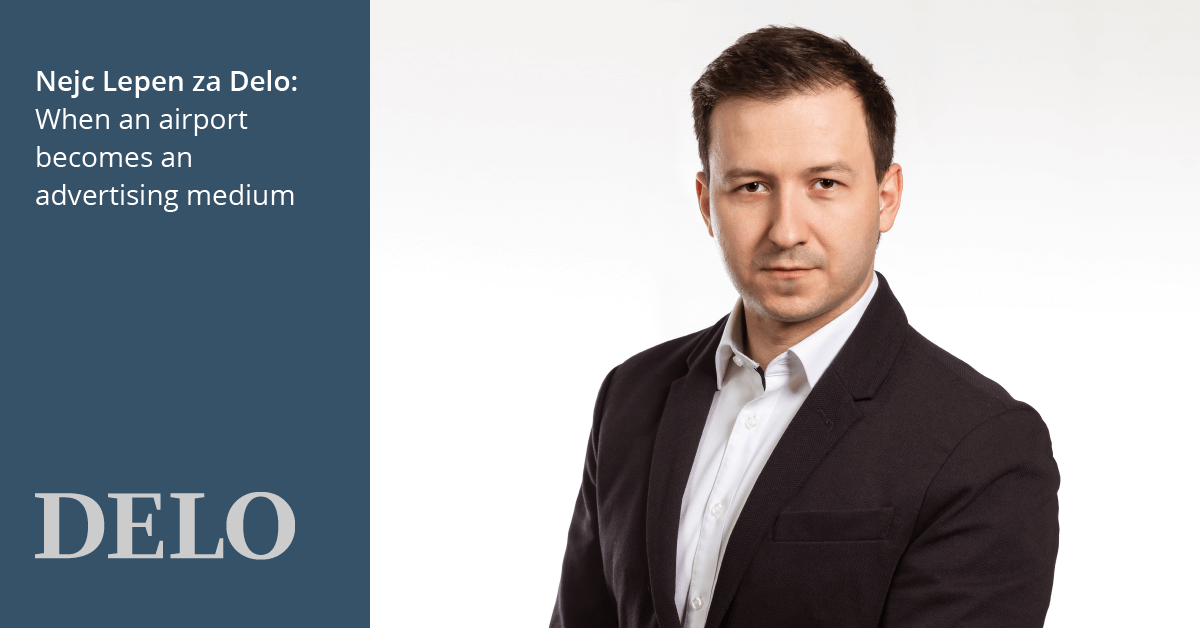The digital transformation of the media inventory of Ljubljana Jože Pučnik Airport is an example of good practice for monetizing proprietary media assets.

In recent years, there has been a lot of talk about digital transformation across all industries. The core idea behind the digital business transformation is to connect and interweave digital and physical technologies by leveraging cloud services, artificial intelligence, the Internet of Things, robotics, and automation to provide more flexible, responsive, and connected forms of data-driven operations.
COVID-19 has doubtlessly accelerated this process. Never before have companies been as aware of the potential of technology and why data mustn’t be stored in Excel but in data silos that have API integrations with other company systems. This is the only way to use this data when it is needed for better business decision-making as well as for planning and performing other activities.
The year 2020 has forced many companies along the path of digital transformation. Some have set up online stores, while others have only just now realized that a business virtually does not exist without a website and that digital channels have become the most effective point of contact with the consumer when there are so many obstacles in the way. However, some companies are no strangers to digital transformation and have skillfully leveraged the potential of digital technologies in the past. This holds true when it comes to digital marketing as well.
Fraport Slovenija is one such company. It uses digital channels and marketing channels effectively and also integrates them innovatively and efficiently to drive added value for users and create a new digital ecosystem for advertisers where the availability of data is the true advantage.
As the company develops these systems, it works with many trusted partners, including iPROM, a digital advertising technology pioneer.
“At iPROM, we believe that 2020 has opened up even more opportunities to find synergies as companies use technology to drive efficiencies and open up new opportunities. I am convinced that the winners are and will be the companies that seek and find these synergies and strengthen interdepartmental cooperation to exceed goals and deliver above-average data-driven user experiences,” says Nejc Lepen, Development Manager at iPROM.
If the airport can be transformed into a medium
Lepen hails Ljubljana Jože Pučnik Airport as a great example of good practice. In terms of marketing communication, an airport is a unique location for reaching the target group of consumers, who are otherwise difficult to reach through other communication channels. Fraport Slovenija was developing and upgrading its advertising infrastructure and wanted to develop services that will further upgrade the airport’s digital advertising ecosystem which is currently under construction and will be ready in the new passenger terminal, which is expected to be completed and opened in the summer 2021. The new system will also ensure improved monetization of the airport’s proprietary media capabilities.
To make this goal a reality, the airport operators worked with iPROM’s digital technology experts to establish a platform that would integrate all Fraport Slovenija’s digital media assets, which comprise digital signage, its website, and the airport Wi-Fi network. The result is a unique technological solution both in terms of technology and the potential it offers to advertisers. Advertisers can now use the airport’s potential as an advertising location more effectively. It provides centralized campaign management available across all digital media at the airport location.
It is also possible to deliver personalized content that is integrated across individual points of contact and follows the passenger as they make their way through the airport. When it comes to the standards and technology used, the new advertising infrastructure is designed from the ground up to connect to the global system for programmatic advertising and media space trading. This makes Ljubljana Airport one of the first airports with such an advertising infrastructure.
A key advantage of the new ad management platform is the ability to use advanced iPROM DMP technology to collect and use data from a variety of back-end systems. Using third-party (e.g., flight, airline, weather, location information) and passenger data, advertisers can adapt the content of their campaigns in real-time. Digital media at the airport has already been tested by commercial and hospitality providers and their suppliers, airlines, travel agencies, and many domestic and foreign advertisers that advertised their services and products to target consumer groups with high purchasing power.
Achieving great results
Fraport Slovenija delivers the best bang for their buck to their advertisers and simultaneously integrates various digital consumer touchpoints to drive added value – improved consumer insight, the possibility of personalized consumer communication, and changes to creative solutions leveraging data from back-office systems. The fact that the new digital advertising landscape works was confirmed by an independent external study, which found that the average ad visibility at the airport was around 60%, with a very high share of purchase intent measured, reaching almost 50% for the best ad. The conversion rate at the airport in terms of commercial or hospitality purchases based on ads exceeded 20%, which is significantly better than traditional advertising methods.
“While we started testing so-called dynamic creatives in digital advertising years ago, they have become an important element of digital strategies in the time of hyper-personalization. They are built on data that is processed with automation procedures and advanced algorithms and allow businesses to create messages in real-time using content and designs that address the consumer more effectively,” Lepen described the fresh and effective advertising approach.
The advertising ecosystem being deployed at the airport also offers advanced analytical capabilities that will become even more effective once passenger traffic recovers to provide more data. This will allow advertisers to accurately profile passengers based on their travel habits, flight characteristics, and airport experience and communicate with them even more effectively.
Advertising is becoming increasingly digital and the example of the digital transformation of advertising capacity at the airport is proof that media platforms are increasingly intertwined and that we live in an age of always-on consumers who can access information and personalized offers in real-time virtually anywhere and anytime.
“Ljubljana Airport will probably come to life next year when things normalize a bit. However, it is definitely a great example of a new digital ecosystem that companies can also monetize and create an additional revenue source or create a platform that drives forward the ecosystem in which they operate. IPROM has already showcased similar Internet of Things application solutions. In 2016, the company deployed programmatic distribution of advertising messages on the international network of Printbox kiosks and in taxis,” concluded Lepen.
The article was originally published in a national daily newspaper Delo in the section Business and Money: When an airport becomes an advertising medium (page 1 and 6-7)
